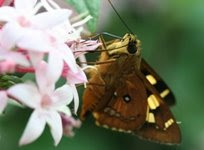Swallowtail butterflies are some of the most beautiful wildlife residents of our tropical Australian forests. Many of the tropical butterflies found (or seen) in our tropical rainforests are known as swallowtails. These beautiful wildlife species have tails attached to their hind wings. They usually also have spectacular colour patterns on their wings. Some of the larger swallowtails are known as birdwings, and fly in a gliding, then flapping pattern that reflects the sunlight off their wings...just amazing to see!
Swallowtails lay a single egg under a leaf, and the caterpillar, when it hatches out is usually fat, with coloured spines to protect it against predators. After going into the pupal stage, some species will remain in this state for several months, while others hatch in a much shorter time. When hatched these beautiful butterflies find a favored perch, then flutter about gathering nectar from nearby flowers. Various vines and rainforest plants are used by swallowtails. Adults feed off the nectar in the flowers, while caterpillars feed off different plants, some which are poisonous to their predators.
Unlike birdwatching, when one has to up "with the birds", the best time of the day to watch some wildlife, including butterflies, is in the afternoon when the sun is warm. .Some birdwings range from the tropical North down to Victoria but most favor the warm tropical rainforests of Queensland. Getting a photo is sometimes a challenge, but patience and perseverance will usually pay off. *WPAA
Tuesday, June 23, 2009
Thursday, June 18, 2009
Setting up Your Butterfly Garden!
As with any other garden project, planning is important.
Draw a map of your habitat area, and make a note of what plants and shrubs you have now, and which of those ones, if any, will attract butterflies. Visit your local botanical gardens and/or nature center, read some butterfly guide books from your local library, and make a list of those plants you will need to acquire.
You will need to find about what species of local butterflies are in your area, and what host plants they use. They don’t just lay eggs on any plant, they have specific plants that the young caterpillar can eat, as it matures to chrysalis stage.
Butterflies like reds, pinks, oranges, yellow, purple, white and blue. They also have a three phase breeding cycle, from egg to chrysalis, to butterfly. The butterfly stage life span is often only a few days. They sip nectar through a long proboscis, which tucks up under the head when not in use.
Moths are very similar to a butterfly, except moths usally feed at night. Some of them are very beautiful. Larval stages of both are caterpillars, and feed on leaves. If you plant the plants that butterfly larvae feed on, you will attract butterflies.
Draw a map of your habitat area, and make a note of what plants and shrubs you have now, and which of those ones, if any, will attract butterflies. Visit your local botanical gardens and/or nature center, read some butterfly guide books from your local library, and make a list of those plants you will need to acquire.
You will need to find about what species of local butterflies are in your area, and what host plants they use. They don’t just lay eggs on any plant, they have specific plants that the young caterpillar can eat, as it matures to chrysalis stage.
Butterflies like reds, pinks, oranges, yellow, purple, white and blue. They also have a three phase breeding cycle, from egg to chrysalis, to butterfly. The butterfly stage life span is often only a few days. They sip nectar through a long proboscis, which tucks up under the head when not in use.
Moths are very similar to a butterfly, except moths usally feed at night. Some of them are very beautiful. Larval stages of both are caterpillars, and feed on leaves. If you plant the plants that butterfly larvae feed on, you will attract butterflies.
Attracting Butterflies!
To attract butterflies in your wildlife habitat you must use native plants that grow naturally in your own area. You simply set up an ecosystem that is sustainable, provides flowering plants, and maintains itself. This is not as hard as it sounds, and it will be a very nice area for you to relax in!
One of the biggest off-puts to butterflies are lawns, driveways, and large open spaces. The more opportunistic bird species like these conditions, but butterflies do not. They like edges, where they can get some sunlight, flowers and insects for food, and water not too far away.
Most of all they like to be close to dense shrubs where they can hide if a threat appears.
They especially like to have flowers to sip nectar from, not too close to the ground, and in the sun, and they like to rest in the sun as well. It’s not that hard to set up a small backyard or balcony butterfly sanctuary, and it can be done over several planting seasons.
One of the biggest off-puts to butterflies are lawns, driveways, and large open spaces. The more opportunistic bird species like these conditions, but butterflies do not. They like edges, where they can get some sunlight, flowers and insects for food, and water not too far away.
Most of all they like to be close to dense shrubs where they can hide if a threat appears.
They especially like to have flowers to sip nectar from, not too close to the ground, and in the sun, and they like to rest in the sun as well. It’s not that hard to set up a small backyard or balcony butterfly sanctuary, and it can be done over several planting seasons.
Subscribe to:
Posts (Atom)

